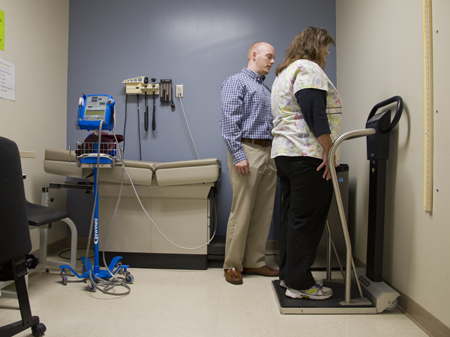Waist size tops BMI as obesity measure, experts say

One of the biggest health issues facing Mississippi and the nation is obesity, yet the way the problem is measured remains debated.
While the Centers for Disease Control and Prevention has popularized the Body Mass Index, a formula using a person’s height and weight as an effective way to identify obesity, the location of body fat isn’t taken into account.
“The fat that’s in your abdomen -- the visceral fat around the organs -- is what’s important in increasing risk for cardiovascular disease and diabetes,” said Dr. John Hall, chair of the Department of Physiology and Biophysics and lead investigator for the University of Mississippi Medical Center’s Mississippi Center for Obesity Research.
Most of the chronic diseases for which obesity is a risk factor are related to the visceral, or deep, fat, he said. The subcutaneous fat, the kind found under the skin in areas such as the thighs or buttocks, may not cause as many problems.

“Unfortunately, much of the data that we have from national surveys does not assess visceral fat,” said Hall. “The Basic Risk Factor Surveillance Study of the CDC, which is the one that is so widely quoted,” is conducted through a series of telephone interviews in which people are asked for their height and weight to calculate BMI.
The BMI does permit assessment of how much fat tissue a person has or where the fat is located, Hall said.
Another CDC study, the National Health and Nutrition Examination Survey (NHANES), where measurements including waist circumference along with height and weight are taken, tends to be more accurate, Hall said.
One of the things that’s been found with both studies is they don’t match up exactly, he said. “The obesity rates that come from the NHANES data are higher than the ones that come from the much more widely used one.
“The reason is that most obese people underestimate their weight,” he said.
That phone interview method relies heavily on the respondent being truthful when reporting the measurements, an expectation that is not always met. A 2013 study published in the journal Obesity by researchers at the University of Alabama at Birmingham found that respondents were not always forthcoming when giving their weight.
“Minnesota was one example where the telephone data suggested they weren’t so fat, but actual measurements indicated they were fatter than they thought,” said Hall.
“In Mississippi, we were pretty close to what we said we were,” he said. “Perhaps Mississippians were more truthful when reporting their weight.”
For those looking to lose excess weight, there’s not a magic way to target just the waistline when slimming down.
“Where excess body weight is stored is primarily determined by genetics,” said Paul Robertson, a registered dietitian at UMMC. “Some people tend to accrue weight in different areas of the body.”
So, Robertson said, getting rid of excess weight comes down to the two standard things: healthy eating and exercise.
Robertson said taking in fewer calories is a general recommendation for combating weight problems, but for some people, fat around the waistline is “the very last thing that comes off when they’re losing weight.”

UMMC pediatrician Dr. Will Sorey believes using BMI to gauge his patients’ obesity is “handy, but I agree with Dr. Hall in that you should ‘beware the pear (or apple) shape.’
“Debating the merits of indexes of body mass is like debating the brand of truck that is already running you into the pavement,” Sorey said. “The bottom line is the abject failure of any sure-fire weight control with the American diet.”
Healthy eating and exercise are going to be the way to get the waistline and the visceral fat under control, experts say.
“They’re both like insurance policies. As long as you’re doing them both and don’t have other medical problems impacting weight management, you should have some degree of success with your weight goals,” Robertson said.


